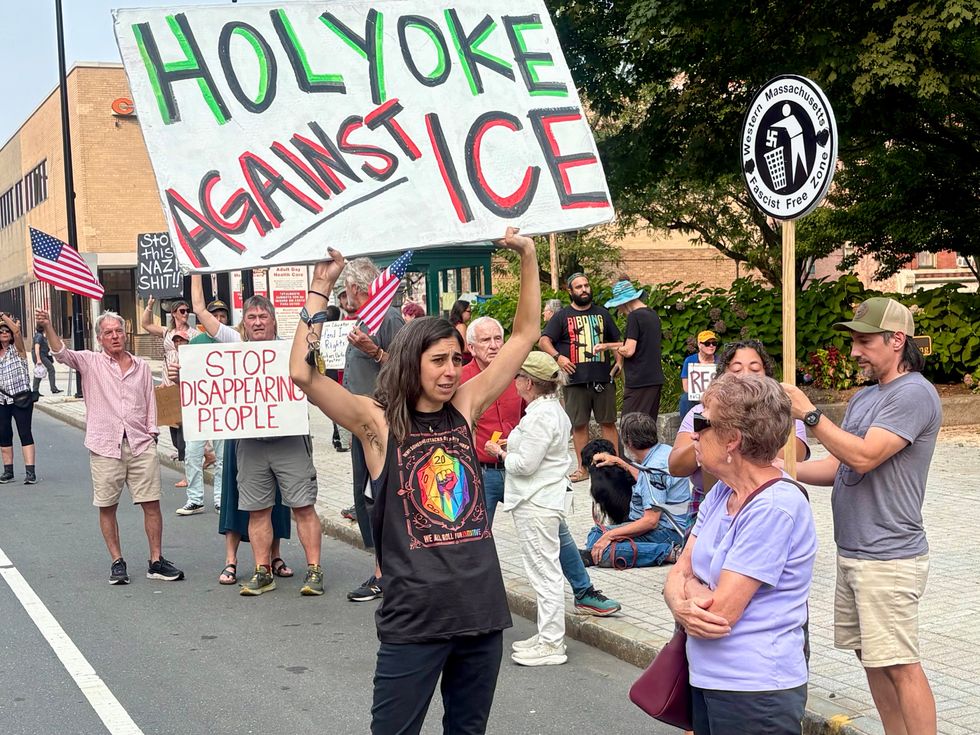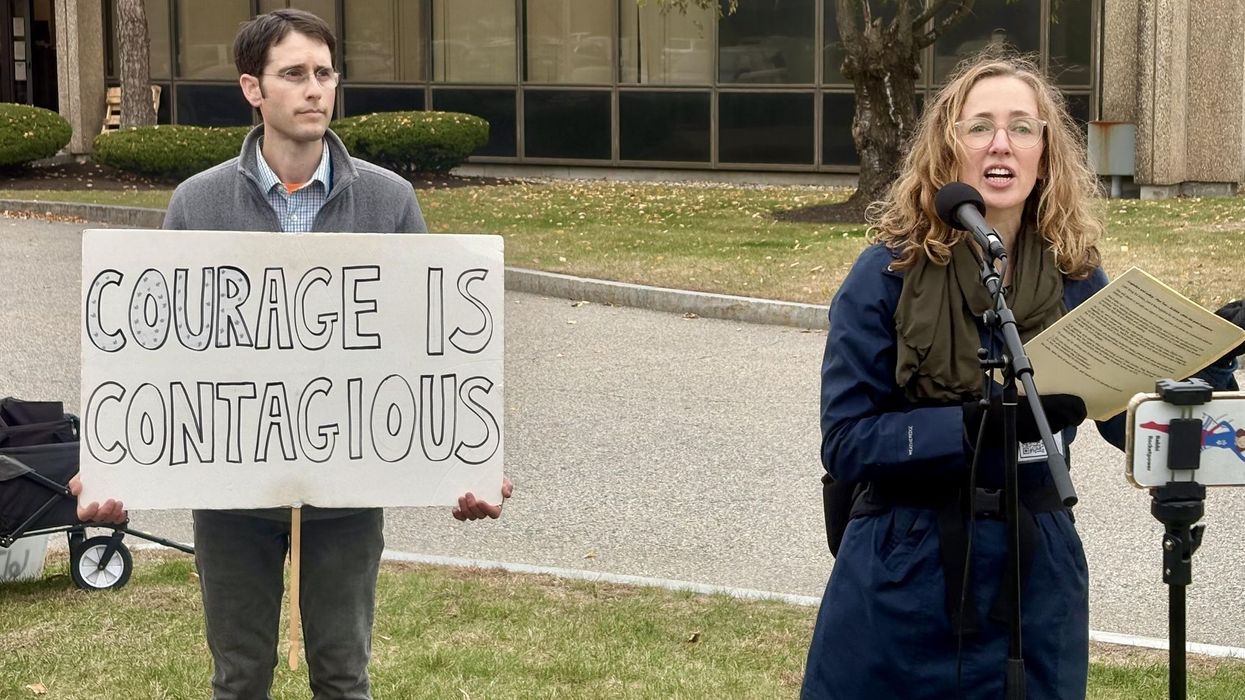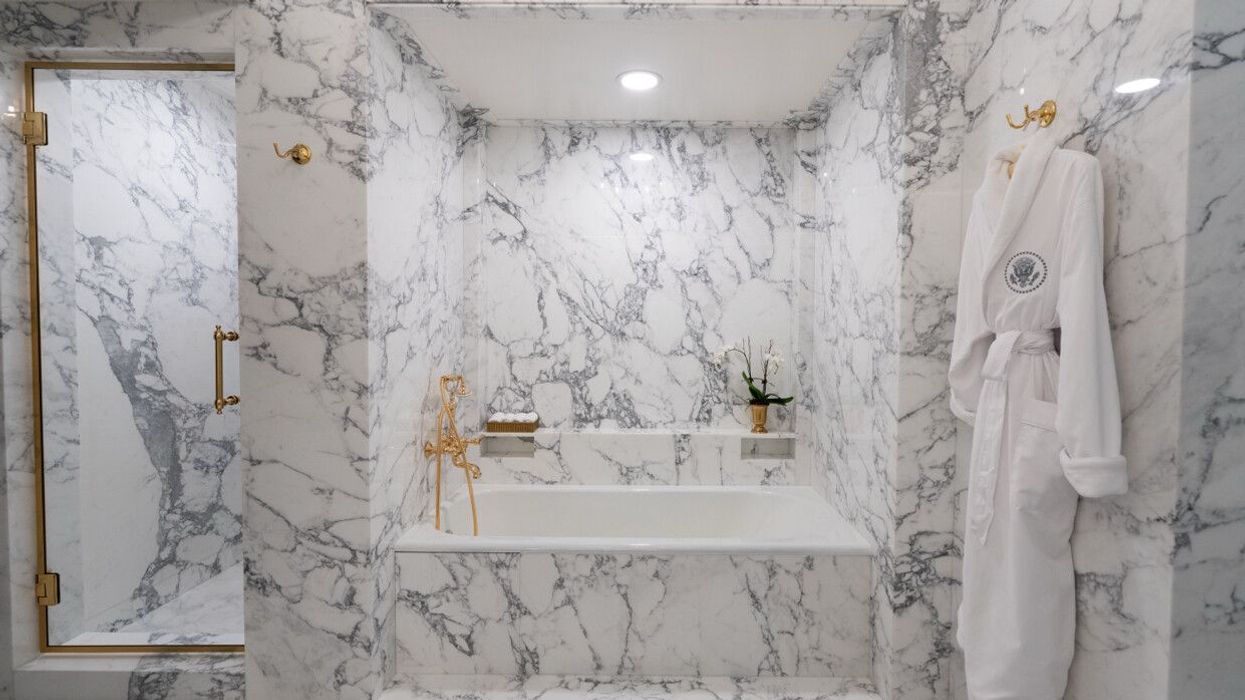It Starts With a Single Sign: In Praise of Everyday Americans Defending Democracy
We need more Jared and Laurie Berezins who are standing up for democracy as civil rights and due process rights are being undermined by the Trump administration.
For Jared and Laurie Berezin who live outside Boston, the final straw was the video in mid-April showing an Immigration and Customs Enforcement agent in New Bedford, Massachusetts shattering a Guatemalan couple’s car window with an axe before dragging them out onto the sidewalk.
One week later, on April 23, the couple—an MIT lecturer and a jewelry maker—held their first protest outside ICE’s New England field office in Burlington, Massachusetts.
Standing alone on a grassy knoll holding a sign, reading, “Just Say No to Harassing Immigrants,” they watched ICE agents coming and going from the two-story ICE facility where thousands of immigrants have been detained, many for multiple days, since January. Both were struck by the casualness of it all, especially the unmasked agents walking around laughing and joking.
They also saw dozens of immigrants arriving, looking stone-faced and nervous, for their deportation hearings. Coming out, a few of them waved to the couple to thank them for their support.
History—from the American Revolution to the civil rights movement—has shown that chipping away at vital institutions can erode political power and force positive change.
Those twin moments—ICE agents performing their jobs with apparent nonchalance against a backdrop of immigrants looking petrified and powerless—struck a chord.
“The minute we started standing on that grass, it hit us that we needed to keep coming back,” Jared Berezin recalled.
One week later, four friends joined their protest. Six weeks after that, there were 60. On December 3, the 33rd consecutive Wednesday protest, there were more than 600.
Beyond speeches and songs, the “Bearing Witness” standouts are producing action: In October, after widespread media attention, the Burlington Town Meeting voted overwhelmingly in favor of a resolution demanding that the ICE facility end “inhumane” conditions and all overnight detentions, which violate local zoning limits set in 2007 when the facility first opened. After repeated requests from federal legislators, ICE has consented to site inspections in the coming weeks.
This is what peaceful, sustained civil resistance looks like.
We need more Jared and Laurie Berezins who are standing up for democracy as civil rights and due process rights are being undermined by the Trump administration.
But resistance needs strategy, training, and unwavering commitment to exercise that power.
In small but encouraging ways, it is happening. One Million Rising, a national civil resistance movement launched in July by the nonprofit group Indivisible, now has more than 350,000 trained volunteers organizing protests, sit-ins, and other types of nonviolent interference aimed at businesses, federal agencies, and other entities supporting the president’s policies.
This has less to do with broad-based demonstrations, such as October’s No Kings Day, and more with sharply focused, continuous collective action to disrupt key pillars of support, such as businesses and government enforcement agencies, that the administration is relying on.
History—from the American Revolution to the civil rights movement—has shown that chipping away at vital institutions can erode political power and force positive change. The president cannot be effective without airplanes to handle his deportation flights, banks that finance his detention centers, and a media that spreads his misinformation and squelches truth.
We’re seeing positive progress across the board.
When Disney and its ABC affiliate suspended Jimmy Kimmel’s show in September over his remarks about Charlie Kirk’s fatal shooting, viewers quickly responded. Disney’s streaming apps lost more than 1 million paid subscribers in a matter of days. The show was quickly restored—a major victory for free speech.
Avelo Airlines, a budget commercial airline that flies out of Hartford, New Haven and dozens of other US cities, is also facing intense opposition over its contract to handle deportation flights for ICE. After numerous protests at Bradley Airport, Avelo announced in October that it was ending all Bradley flights. Similar protests are underway in New Haven and other airports.
Protesters are also targeting local governments such as Holyoke, Massachusetts, a mostly Latino city sensitive to escalating ICE raids. Like Burlington, the first protest was started last spring by a young woman, Claire McGale, who stood alone at a popular street intersection holding a sign reading, “Solidarity Without Action is Meaningless.”

The weekly protests swelled. McGale then organized a diverse coalition, The Real Holyoke Majority, that took its protests to City Hall where city councillors were considering a resolution declaring that Holyoke is not a sanctuary city and supports all federal laws, including ICE raids. In October, after Latinos, youth, and trans residents spoke in opposition, the resolution was defeated in a 7-6 vote. A few weeks later, the councillor leading the resolution effort was voted out of office
The movement needs more people like Claire McGale and Jared and Laurie Berezin.
They are writing American history right now. What will your story be?


